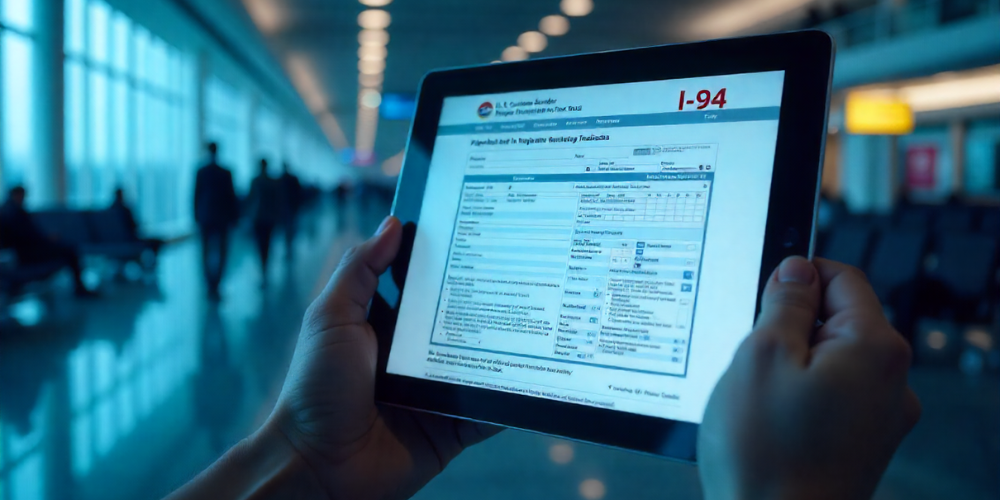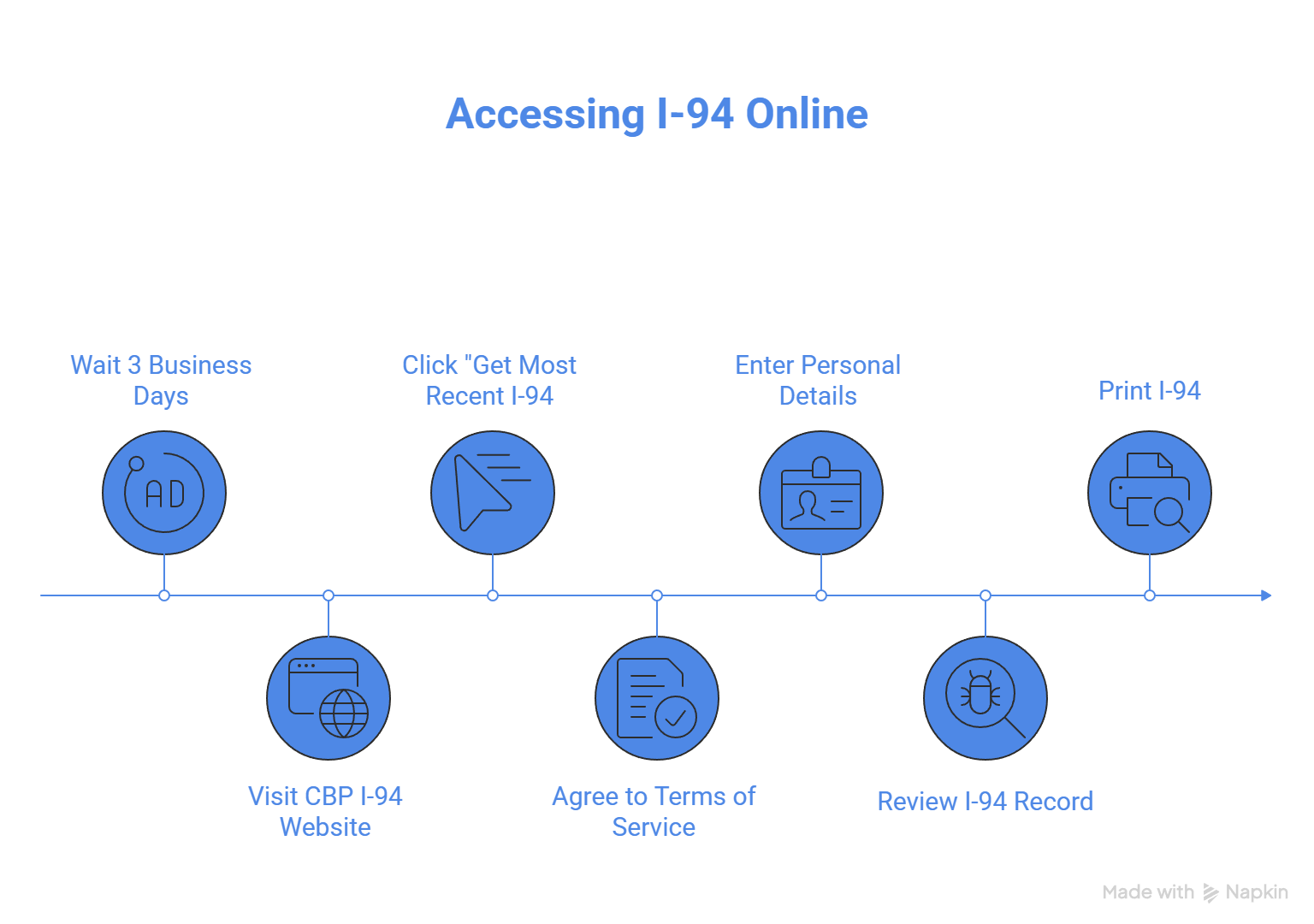
For international students, crossing into the United States is more than just a flight or a border check—it’s the beginning of an academic journey. And at the very heart of that entry is a document often overlooked but absolutely vital: Form I-94. This “Arrival/Departure Record” is the official stamp of approval that proves you’ve been lawfully admitted into the country.
Why does it matter? Without it, you can’t prove your legal status, secure on-campus jobs, or renew your visa when the time comes. Think of the I-94 as your quiet but powerful companion—it won’t get you into class, but it will open the doors to everything else you need to stay and thrive in the U.S.
In this guide, we’ll break down exactly how international students can get their I-94, whether arriving by air, sea, or land. Step by step, we’ll walk through how to access your record online, what to do if there are mistakes, and how to keep it safe for when you need it most.
What is Form I-94?
Form I-94, officially known as the Arrival/Departure Record, is a U.S. government-issued document that tracks when and how you entered the country. It’s not just a bureaucratic form—it’s the piece of paper (or electronic record) that proves you are here legally.
For international students, the I-94 is essential to maintaining lawful status. It spells out your visa category (usually F-1 for students) and how long you’re allowed to remain in the U.S. under that status. Most I-94s for students will say “D/S” (Duration of Status)—meaning you can stay as long as you maintain your student visa requirements.
But beyond simply confirming your stay, the I-94 becomes part of your everyday administrative life. You’ll need it when:
-
Applying for employment authorization or completing the I-9 form with a new job.
-
Renewing or extending your visa with U.S. Citizenship and Immigration Services.
-
Handling official paperwork tied to your immigration status.
In short, your I-94 is your silent but crucial ticket to living, studying, and working in the U.S. as an international student.

How International Students Receive the I-94
The way you receive your I-94 depends on how you enter the United States. The process looks slightly different for air and sea travelers compared to those crossing a land border.
✈️ Arriving by Air or Sea
-
If you’re flying into the U.S. or arriving by ship, your I-94 is created automatically when you go through inspection at the port of entry.
-
You won’t be handed a paper copy; instead, the record is stored electronically.
-
To access it, you’ll need to log in to the official CBP website after arrival.
🚗 Arriving by Land Border
-
Crossing into the U.S. by land? You may receive either an electronic record or a physical, paper I-94 card.
-
If you do get a paper version, keep it safe—it’s your proof of lawful admission and you’ll need it for visa compliance and official paperwork.
In both cases, whether paper or digital, your I-94 becomes the cornerstone of your legal status as an international student.
Step-by-Step: How to Access Your I-94 Online
If your I-94 is issued electronically, retrieving it is simple—but it does require a bit of patience and precision. Here’s how to do it:
1. Wait 3 business days after arriving in the U.S. to allow the system to process your entry record.
2. Go to the official CBP I-94 website: i94.cbp.dhs.gov.
3. Click “Get Most Recent I-94” from the options provided.
4. Agree to the terms of service to move forward.
5. Enter your details exactly as they appear in your passport—this includes your full name, date of birth, and passport number.
6. Review your I-94 record, which will display:
– Your unique I-94 number
– Date of entry
– Visa classification (e.g., F-1 for students)
– “Admit Until” date (often marked D/S for “Duration of Status”)
7. Print your I-94 and keep it with your important documents. This printed copy often comes in handy for jobs, immigration forms, and even certain university requirements.

Checking Your I-94 for Accuracy
Once you’ve pulled up your I-94, don’t just print it and toss it into a folder—check it carefully. Even small mistakes can snowball into major issues later on.
Common errors include:
– Visa classification mistakes (e.g., showing B-2 tourist instead of F-1 student).
– Incorrect “Admit Until” dates (should usually be listed as D/S – Duration of Status for F-1 students).
If something doesn’t look right, don’t panic—but don’t ignore it either. The first stop should be your university’s international student office, where advisors are trained to spot and resolve these errors. In some cases, you may also need to contact U.S. Customs and Border Protection (CBP) directly to get your record corrected. Catching these issues early can save you endless headaches with work authorization, visa renewals, and maintaining status.
Additional Features & Uses of I-94
The I-94 isn’t just proof of admission—it’s a multifunctional record that you’ll use throughout your stay.
✨ Extra features on the CBP website:
-
View your five-year travel history, which can be helpful when filling out visa applications or immigration forms.
📌 Common uses of the I-94 for students:
-
Employment authorization paperwork – You’ll need it when completing the I-9 form or applying for a Social Security Number.
-
Visa extensions or status changes – USCIS will often request a copy of your most recent I-94.
-
General immigration paperwork – From renewing your driver’s license to submitting forms, the I-94 is often a required attachment.
In short, think of your I-94 as a cornerstone of your U.S. paperwork—something you’ll return to again and again.
What If You Cannot Retrieve or Lose Your I-94?
Technology glitches, typos, or simple misplacements happen. If you can’t retrieve your I-94 online or you’ve lost a paper card, here are your options:
– File Form I-102 (Application for Replacement/Initial Nonimmigrant Arrival-Departure Document): This is the official route for getting a replacement.
– Seek help from your international student office: Advisors can guide you on whether you need to file the form or if CBP can fix the issue directly.
– Contact CBP for troubleshooting: Their Deferred Inspection Sites or Help Desk can sometimes resolve problems without the need for extra paperwork.
Resource tip: Always keep a backup—store a PDF copy and a printed copy of your I-94 in safe places. That way, if the unexpected happens, you’ll have proof of status ready to go.
Best Practices for International Students
Managing your I-94 doesn’t have to be stressful—it just requires a bit of routine. Here are some tried-and-true practices every international student should follow:
– Always keep a printed copy: Even though the record is electronic, many schools, employers, and agencies will ask for a physical copy.
– Double-check accuracy after every entry: Each time you re-enter the U.S., log in and confirm your visa classification and “Admit Until” date.
– Save both electronic and paper copies: Store a PDF in a secure folder on your computer and cloud drive, and file away a printed version with your important documents.
– Know where to go for help: Your university’s International Student Services (ISS) office should be your first stop, followed by CBP or official government resources if issues persist.
Think of these practices as your “I-94 toolkit”—a small effort now that pays off in peace of mind later.
Helpful Resources
Here are some trusted links to guide you through every stage of the I-94 process:
CBP I-94 Official Website – Retrieve your record, view travel history, and learn more about the form.
Study in the States: How to Access Your I-94 – A student-friendly step-by-step guide.
University of Washington ISS Guide – University-level instructions with examples.
Yale OISS Explanation of I-94 – An overview of the form and why it matters.
ICE: DHS Streamlines Access to Travel Records – Updates on improvements to the I-94 system.
Conclusion
The Form I-94 might seem like a small detail in your international student journey, but it’s anything but minor. It’s the official proof that you’re in the U.S. legally, the backbone of your immigration paperwork, and a document you’ll use time and again.
Make it a habit: check it, print it, safeguard it. If errors appear, address them quickly with your school’s international office or CBP. With the right precautions and support, your I-94 will remain a reliable key to studying, living, and thriving in the United States.

